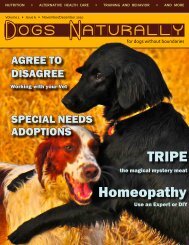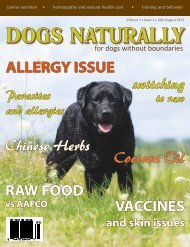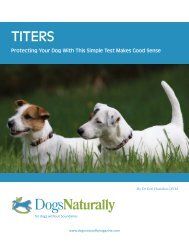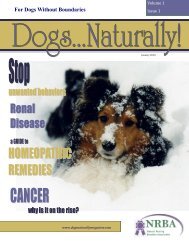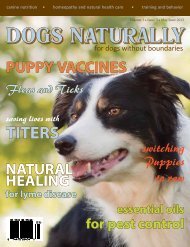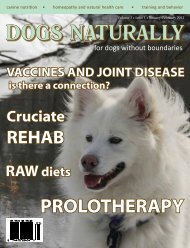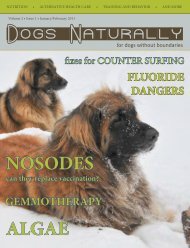July/August 2010 - Dogs Naturally Magazine
July/August 2010 - Dogs Naturally Magazine
July/August 2010 - Dogs Naturally Magazine
Create successful ePaper yourself
Turn your PDF publications into a flip-book with our unique Google optimized e-Paper software.
By: Michael W. Fox<br />
BVetMed, PhD, DSc, MRCVS<br />
PART II<br />
Herbicides and Digestive System<br />
Bacterial Health<br />
It is not widely understood that the digestive<br />
tract is not simply an organ system<br />
designed for the assimilation of food. It is<br />
our primary organ of defence against potentially<br />
harmful food and water-born toxins,<br />
viruses, bacteria, and other potentially<br />
harmful organisms. Integral to this lymphatic-intestinal<br />
defence system is the<br />
population of intestinal ‘flora’---bacteria<br />
and other micro organisms -- that are symbiotic,<br />
having a symbiogenetic relationship<br />
with the cells of the gut that recognize<br />
them immunologically as eubiotic enteric<br />
residents (i.e. helpful resident organisms).<br />
This is an adaptive response because these<br />
enteric bacteria act as a defence against<br />
invasive organisms, and provide the cells<br />
with various nutrients essential to the<br />
health and functional integrity of the rest<br />
of the body, much as the mycorrhyza do<br />
around the roots of plants.<br />
Agrichemicals, especially the herbicide<br />
residues in GM crops and their even more<br />
toxic breakdown products, when digested<br />
by humans and their pets, could cause a<br />
host of health problems if the normal gut<br />
flora is harmed. If this healthy, disease-<br />
preventing, nutrition-providing, and immune<br />
system-supporting population of<br />
symbiotic bacteria in the intestines is disrupted,<br />
nutritional deficiencies, overwhelm-<br />
ing bacterial infection (Clostridia in dogs,<br />
for example), increased susceptibility to<br />
‘allergies’, and other neuroendocrine and<br />
metabolic changes may ensue. These health<br />
problems have been linked in recent research<br />
to imbalances in the intestinal bacterial<br />
population where some species of bacteria<br />
come to dominate.<br />
This condition of dysbiosis is compounded<br />
by the over-prescribing by doctors of antibiotics<br />
and their wholesale use in livestock<br />
feed. What we have done to our digestive<br />
system bacterial flora and to that of our<br />
companion animals mirrors what we have<br />
done to the life of the soil.<br />
The most widely used herbicides sprayed<br />
on GM (genetically modified or engineered)<br />
herbicide-resistant cotton, corn,<br />
soybean and canola, such as Monsanto’s<br />
Roundup (glyphosate) and Bayer’s Ignite<br />
(glufosinate), can also have toxic effects on<br />
the body. Glyphosate may be an endocrine<br />
disruptor, and in test animals has caused<br />
elevation of some liver enzymes and calcium<br />
oxalate crystals to form in the urine,<br />
along with inflammatory changes in the<br />
kidneys and lower urinary tract. Glufosinate<br />
can inhibit glutamine uptake. Deficiency<br />
of this amino acid is linked with<br />
bowel/digestive problems, impaired immune<br />
function, and possibly obesity due to<br />
increased appetite. It may be no coincidence<br />
that glutamine is widely prescribed<br />
for pets with ‘leaky gut’ syndrome and inflammatory<br />
bowel disease, and probiotics<br />
and prebiotics (like inulin and oligofructose)<br />
prescribed to help animals with allergies<br />
and other related health problems.<br />
Dysfunctional Agriculture, Hazardous<br />
Foods<br />
We should not be surprised that there are<br />
so many nutrition-related health problems<br />
when we look at the soil that is used to<br />
produce food commodities that are not<br />
organically certified. As one California<br />
farmer told me some thirty years ago,<br />
‘Farmers today just use the soil to prop up<br />
their plants. Then they pour on the<br />
chemical fertilizers that they must, because<br />
they killed the soil with pesticides.” Petrochemical-based<br />
agriculture has made our<br />
life-sustaining soil deficient in micro organisms<br />
that provide vital nutrients to the<br />
plants---and so our staple foods are also<br />
nutrient-deficient, especially in essential<br />
trace minerals and antioxidants like magnesium,<br />
zinc, and selenium.<br />
Dead soil means no food without chemical<br />
fertilizers, herbicides, nematodicides, fungicides,<br />
insecticides, agricultural biotechnology’s<br />
genetically engineered, cloned, and<br />
patented ‘improved’ varieties of crops and<br />
animals, with a frosting of USDA- & FDAregulated<br />
food irradiation. While denying<br />
that Mad Cow Disease could be an endemic<br />
problem in US cattle, it is notable<br />
that the FDA prohibited the inclusion of<br />
brain and spinal chord in pet foods (the<br />
primary source of prions responsible for<br />
this neurological disease in cattle, pets and<br />
people), soon after the exposé of ‘downer<br />
cow’ cruelty at a California cattle handling<br />
and slaughter plant in early 2008.<br />
Studies have shown that crops from organically<br />
certified producers, along with the<br />
<strong>Dogs</strong>...<strong>Naturally</strong>! <strong>July</strong>/<strong>August</strong> <strong>2010</strong>




